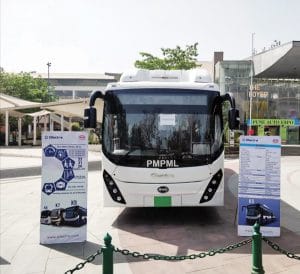Post Covid-19, a significant change in bus electrification is expected.
Story by Deepti Thore
India ranks second in bus population after China globally. Like China, this market too is striving for electrification. It is doing so with the intention of curbing emissions. It is also doing so with the intention of plugging the supply and demand gaps which exist. The post Covid-19 situation has ensured that there is a significant change in the outlook in terms of providing transportation to millions of people as they look at returning to work and travel. While electrification of city buses, a domain that is largely with the public STUs, underway to an extent, and under the premise that these buses are capable of reaching every part of the city, electrification of buses is a factor that has many complexities attached to it. And, this despite the fact that buses are an important mode of transportation and their capacity can be rapidly increased with a modest capital input. Of the opinion that buses need to be put at the centre of policy and developed to full capacity, even if metro systems are implemented, Dr. A K Jindal, Advisor – e-Mobility, New products and Technology, Tata AutoComp Systems expressed that there are several advantages to be reaped. Buses are comprehensive and provide the required connectivity to the peri-urban and rural areas around the city, he added.

Stating that buses are cheaper than other transport mediums in terms of capital as well as the recurring costs per passenger kilometre basis, Dr. Jindal averred that bus operations are also highly as well as quickly scalable in terms of expanding their scope, and also in terms of the change of participation. A prime candidate for the participation of the private sector, bus operations, he explained offer high level of flexibility in terms of adaptation to the change of city plan for example. Capable of being environment friendly through the adaptation of greener and less CO2 emitting technologies, Dr. Jindal informed that bus operations make it easy to implement a national policy or programme that takes into consideration the local and regional needs. Revealing that per passenger trip, buses emit just 10-25 per cent of the particulate matter and Co2 compared to other transport modes, Dr. Jindal said that the shift to e-buses can lead to further reduction in these figures.
e-bus tech
Of the opinion that buses are a crucial mode of public transport in a populous country like India, Sajid Mubashir, Scientist G, Department of Science and Technology, Government of India at Ministry of Science and Technology, mentioned that technology should be modified or adapted to work in a tropical environment like India. For e-buses to be compatible for operation in India, the need for them is to be set to 25 degrees. The need is for the batteries to be compatible. Battery conditions dramatically alter in India due to higher temperatures, Mubashir revealed. With electric buses at an inflection point, there is a need for the right technology, he averred. Touching on the presence of tech-savvy companies in the e-bus space in India, he said that some companies have gone to the extent of adapting their technology to the tropical operations in the country. Stating that a BYD e-bus carries three-tonnes of battery pack which is tropical condition friendly, Mubashir explained that lithium-ion phosphate batteries are safe, but require effective cooling. The BYD bus, he informed, has an onboard charger of 80 kilowatts and hub-mounted motors (motor is inside the wheels). The e-bus, he added, carries not just its own charging apparatus and takes the whole night to charge, its battery is big enough for the bus to run the whole day.
Drawing attention to the operation of city buses in India along well-defined routes and with a fixed passenger load, Mubashir stated that the energy use of such e-buses is predictable. He termed the city bus operations as energy efficient and a good candidate for regenerative braking due to their frequent starts and stops. Informing that a trip length of a typical city bus is generally 40 kms, Mubashir said that repeated small charges during the day, between trips, are good for the battery. Most operators however, do not prefer this (opportunity charging). Pointing at Microvast’s ability to fast charge (20 minute full charge battery), he remarked that they deploy Lithium Titanate Oxide (LTO) batteries.
Highlighting the need for buses to be lighter and sans heavy batteries, Mubashir expressed that opportunity charging needs to be looked at. It needs to be looked at in a situation where utmost reliability, efficiency and sanitisation are the need of the hour. For charging lakh or two lakh buses it is quite difficult to meet that scale with overnight charging. For opportunity charging there are various charging methods which can be used, he informed. There are variations of CHAdeMO, CCS and GB/T which are different methods for battery electric vehicles, explained Mubashir. Revealing that CHAdeMO connector is identical across the globe and is a stand-alone plug that can be with or without an AC connector, he said that its use enables fast charging. Of the opinion that CCS (Combined Charging System) is one of several competing charging plug (and vehicle communication) standards for DC fast charging, Mubashir averred that GB/T, apart from supporting quick charging, enables the vehicle connector to be locked in its bracket to guard against vandalism.
e-bus battery tech
Informing that there are two types of batteries for e-buses, Lithium-ion phosphate and Lithium titanate oxide, Mubashir mentioned that they are suitable for higher temperatures in India. They are safer and temperature tolerant, he added. Developed by Arumugam Manthiram and John Goodenough, Lithium iron phosphate batteries are non-toxic and display excellent thermal stability. They also exhibit good electrochemical performance and holding capacity. Lithium titanate oxide, at the other end, is good for opportunity charging. Batteries made from this material use lithium titanate nanocrystals instead of carbon and have a larger surface area of 100 sq.m/g compared to 3 sq.m/g for carbon. They charge quickly and provide high currents when required. They also have a long cycle life of 10000 cycles at 25 degrees. Even at 55 degrees they give 1000 cycles. Needing to be charged often, batteries made from lithium titanate nanocrystals help meet certain strategic goals. This is true with the other types of batteries as well.
With e-buses often described as the battery trojan horses, the use of battery technology holds much significance. In what is considered as an interesting development, the BYD bus, mentioned Mubashir, carries a battery pack that weighs a good three-tonnes. Yutonghas, he added, carried even bigger batteries. Mubashir opined that the ACC (Battery Cell) manufacturing mission must be linked to the spread of electric buses in India as a large volume of bus batteries would be required. With many organisations in India contributing towards successful operation of electric bus fleets, it is essential that the ACC manufacturing mission is engineered to encourage the spread of electric buses with good availability of batteries, he added. Mubashir also pointed at how the deployment of EVs in Kolkata has earned themselves global recognition on the basis of their planning as an organisation for the plying of buses along the routes, and in terms of infrastructure.
Success story of EV buses in India
Stating that the cost of operation of electric buses is less than that of the diesel buses, Nayana Gunde, Honorary Chairman and Managing Director, PMPML (Pune), informed that the organisation spends Rs.90 per km to maintain a diesel or CNG bus. Under the new financial model, the cost of running a small e-bus is Rs.68 per km and that of running a big bus is Rs.74 per km, she added. PMPL is running around 135 buses in Pune. While organisations like PMPML are coming to see the lower operational costs of e-buses, a more in-depth assessment over the entire lifecycle of the bus is necessary under typical Indian operating cycles and ecological environment. This is especially necessary because despite all the good intentions behind implementing e-mobility, the progress in the development of e-buses has been slow.
Several reasons are being stated for that. Many of these are said to lie in various standard processes and financial developments. There are some factors as well, which are resulting in high anxiety and uncertainty in the adoption of e-mobility. The high initial acquisition cost of e-buses is making government subsidies crucial without a doubt. The Gross Cost Contract (GCC) model is found to be favourable but has its own set of challenges. From the OEM perspective, repeated cancellation of tenders has been one of the issues. They have had to replan time and again. The entry of new players at the other end has added an edge to the competition and has resulted in margins slipping to levels that are hardly viable. Under pressure to keep the fares low, the operating bodies and in-turn the government of states and the centre are finding it tough to support the growth of e-buses on a scale that influence the drop in vehicles emissions from public transport buses considered as a whole.
With the filling of viability gap becoming a big challenge, electrification of buses is facing many challenges. If the Covid-19 situation has added to it, a new way to look at e-buses is made necessary. This is especially true when factors like uncertainty of payments is there. Factors like the need to provide bank guarantees are there. These are highly concerning factors for operators along with high cost of funds and need for long-duration funding. Funding provided for only four to five years is proving to be insufficient. Especially when one considers that a bus operates on the road for 10 years.





















